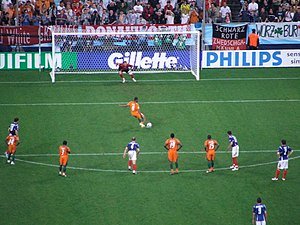- Last Updated -

Soccer Penalty Kick, Soccer Law 14…
In this article we will answer the question “what is a penalty kick in soccer. We will start with a little soccer 101… Soccer, also known as football, is one of the most popular sports in the world. With over 4 billion fans globally, soccer has become a passion for many people across different cultures and ages. The game is played with two teams of eleven players each who aim to score more goals than their opponent.
The team that scores more goals at the end of the game typically wins. Penalty kicks are one aspect of soccer that can change the course of a match within seconds.
Teams can win or lose based on penalty kick Rules of Soccers given by referees during games. This makes penalty kicks an essential element of soccer that every player and fan needs to understand.
Brief Explanation of Soccer as a Sport
Soccer is a team sport played on a rectangular field with two goals at opposite ends. Each team has eleven players consisting of ten field players and one goalkeeper.
The objective is to score goals by kicking the ball into the opposing team’s goal post while preventing them from scoring in your own goal post. The game consists of two halves, each lasting 45 minutes, with a 15-minute break in between.
In case both teams have scored equal goals by the end of 90 minutes, extra time or penalty shootouts may be used to determine the winner. Soccer requires physical agility, coordination, teamwork, and strategic thinking from players to succeed on the field.
Importance of Penalty Kicks in Soccer
Penalty kicks are crucial moments in soccer games where one player must face off against another player- usually a goalkeeper- with no intervening teammates except for what has been set up before and during play (for example via formation). These moments are often critical because they can decide who wins or loses a match quickly! A goal scored through this kick gives you significant leverage over your opponent since it counts towards your overall scoreline.
Penalty shots can also change the psychological tide of a match. For example, an underdog team that manages to score a penalty kick against a highly favored opponent may gain much-needed momentum and confidence to turn the game around.

Definition of a Penalty Kick – Law 14
A penalty kick is awarded by the referee in instances where a player from the opposing team commits an offense that would otherwise have resulted in a free-kick being awarded, but instead occurs inside their own penalty area. The ball is placed 12 yards away from the goal line, and only the goalkeeper is allowed to stand between it and the kicker.
All other players must be outside of this area until after the ball has been kicked. The kick itself involves one player kicking the ball towards the opposing team’s goal post with no intervening teammates except for what has been set up before play or through formation.
The goalkeeper must try to prevent this from happening by blocking or catching it. If successful, their team gains possession of the ball and can begin attacking again.
The Setup
Explanation of how a penalty kick is awarded
A penalty kick is awarded to a team when the opposing team commits a foul inside its own penalty area. The referee will award the penalty kick by pointing to the spot on the field where the kick should be taken. If there is any disagreement about whether a foul was committed, or if there are any questions about where the ball should be placed for the spot-kick, then VAR (Video Assistant Referee) can be consulted.
The location and distance from the goal
The location of the penalty mark is always 12 yards (11 meters) away from goal and in line with the center of the goalposts. This distance has been used for over a century and allows for an even match between goalkeeper and kicker. From this position, it takes less than two seconds for a ball to reach the goal if kicked hard enough.
Positioning of goalkeeper and kicker
Once awarded, both teams must follow strict positioning rulesHandball Rule In Soccer before and during taking a penalty kick. The defending team must remain outside of their box until after they have been signaled to move forward by both linesmen signaling that they are ready. The kicker must stand behind or on top of this mark, while all other players except for one goalkeeper remain outside in an area called ‘the arc.’ Goalkeepers cannot move forward off their line until after they have seen which direction the ball has been kicked in.
They also cannot touch any part of their goalpost or bar before making contact with an incoming ball. Overall, understanding these rules about how penalties are set up will help you better appreciate what goes into each attempt at scoring from this exciting moment in soccer!

The Process
Steps taken by the kicker before taking the shot
Penalty kicks are often considered one of the most nerve-wracking moments of a soccer match. As such, it’s crucial for the kicker to have a well-executed routine that they can rely on in high-pressure situations. This routine typically includes several steps that are performed before taking the shot.
Firstly, the kicker will typically visualize their approach and where they intend to place the ball. Many players will then take a deep breath to help them focus and calm their nerves.
They may also adjust their socks or shirt or take a few steps back from the ball. The next step is to approach the ball with confidence and conviction.
This usually involves a run-up, where players build momentum before striking the ball. Some players prefer to stutter-step or feint during their run-up to throw off the goalkeeper’s timing.
Goalkeeper’s strategy during a penalty kick
The goalkeeper also has an important role in penalty kicks. Their job is to try and anticipate where the kick will go and make a save if possible.
To do this, goalkeepers must analyze various factors leading up to and during a penalty kick. One key strategy for goalkeepers is to watch for cues from the kicker’s body language or positioning as they approach the ball.
This can give them an idea of where they may be aiming. Goalkeepers may also shuffle from side-to-side on their goal line while keeping an eye on both the kicker’s feet and eyes.
Once confident in their positioning, goalkeepers will then attempt to make themselves as big as possible by spreading out their arms and legs while crouching slightly forward. From there, it becomes a game of reaction time as they try to stop any shots that come towards them.
Possible outcomes of a penalty kick
There are several possible outcomes when it comes to penalty kicks. If the kicker successfully scores, the goal is awarded and play continues as usual.
However, if the shot misses the goal or is saved by the goalkeeper, play will resume with a goal-kick or corner kick depending on which team was awarded the penalty. In some cases, players may also attempt to intentionally miss a penalty kick in order to take advantage of rebound opportunities or trick the goalkeeper into diving early.
However, this can be risky as referees may deem it unsportsmanlike conduct and issue a yellow card. Overall, penalty kicks are an exciting and high-stakes aspect of soccer that require skill and strategy from both kickers and goalkeepers alike.

Variations and Controversies
Different Types of Penalties
While a standard penalty kick typically involves one player shooting from the spot 12 yards away from the goal, there are a few variations on the format. In sudden death penalties, for example, each team takes turns shooting until one team scores and the other misses. This format is often used in knockout competitions where a winner must be determined quickly.
Another variation is the shootout, which involves multiple rounds of penalty kicks taken by players from each team until a winner is determined. Shootouts are often used to determine winners in tournament games that cannot end in a draw.
VAR (Video Assistant Referee) Controversy
In recent years, soccer’s governing bodies have introduced VAR (Video Assistant Referee) technology to help referees make more accurate decisions during matches. VAR can be used to review incidents including goals scored, penalties awarded, and red card offenses. However, VAR has proved to be controversial among fans and players alike.
Some argue that it disrupts the flow of games while others believe it takes too long for VAR officials to make decisions. In addition, some fans feel that VAR has led to inconsistent decision making by referees.
Historical Controversies Surrounding Famous Penalty Kicks
Over the years there have been several controversies surrounding famous penalty kicks. One of the most famous examples is Diego Maradona’s “Hand of God” goal against England in the 1986 World Cup quarter-finals. Maradona appeared to punch the ball into England’s net but it was not spotted by referee Ali Bin Nasser who allowed the goal to stand.
Another famous controversy occurred during Euro 96 when Germany defeated England in a shootout after Gareth Southgate missed his penalty kick. Southgate’s miss led to criticism from some quarters and became an enduring symbol of England’s failure to win a major international tournament.
Penalty kicks in soccer are an integral part of the game and have evolved over time to include different variations and technologies like VAR. While they can be a source of excitement for fans, they also come with their fair share of controversies and famous moments that have become part of soccer folklore.
Conclusion
Penalty kicks are undoubtedly one of the most exciting moments in a soccer game. It’s a high-pressure situation where anything can happen, and the outcome can change the game’s course entirely.
We’ve covered the basics of what a penalty kick is, how it’s awarded, its setup and process, and some variations and controversies surrounding it. Let’s now recap some key points we discussed in this article.
Reiteration of Importance of Penalty Kicks in Soccer
Penalty kicks have a crucial role in soccer. They provide an opportunity to score a goal, which is especially important when a game ends with no goals scored by either team. Penalty kicks also test players’ mental strength as well as physical ability since they require incredible accuracy and skill.
The Impact on Soccer Culture and Fans
Soccer fans worldwide eagerly anticipate penalty kicks since they are often deciding factors in close games. The drama surrounding these shots creates an electric atmosphere that spectators love to witness live or on TV screens worldwide.
In addition, fans often discuss famous penalty kicks long after games have ended. Penalty kicks are an essential part of soccer culture that create tense moments for both players and fans alike while testing players’ abilities to execute under high pressure. (1)
Mastering Soccer Jargon: A Glossary for Fans and Players
Last Updated on April 12, 2024 by Andy Long Mastering Soccer Jargon:...
Read MoreBest Soccer Cleats For Goalkeepers 2024
Diving right into the heart of the matter, let's explore a question...
Read MoreThe Transformation of German Soccer in the 2000s
Kickoff: A Brief Overview of German Soccer in the 2000s The Dawn...
Read MoreBest Soccer Cleats for Women In 2024: Top 5 Picks
The Best Soccer Cleats for Women in 2023: Top 5 Picks The...
Read MoreThe Historical Dominance of Brazilian Soccer in the World Cup
Introduction: The Beautiful Game's Grandest Stage The World Cup, a grand tournament...
Read More5 Best Soccer Cleats For Strikers in 2024
What are the Best Soccer Cleats for Strikers? The beautiful game of...
Read MoreAn Introduction and History of UEFA Champions League
In terms of prestige, nothing surpasses lifting ‘the cup with big ears’,...
Read MoreThe Golden Era of Italian Soccer in the 1990s
A Glimpse into Italy of the 90s: Culture, Politics, and Soccer As...
Read MoreWhat is a goal kick in soccer? Soccer Law #16
Soccer is governed by a set of rules known as the Laws...
Read MoreConcussion Substitutions in Soccer: evolving concussion protocols
The Growing Concern for Player Safety in Soccer Soccer, a beloved sport...
Read MoreThe Impact of VAR on Modern Soccer: Video Assistant Referee
Traditional Refereeing Methods: Balancing Act on the Pitch In the realm of...
Read MoreThe Changing Role of Inverted Wingers
Definition of 'Inverted Wingers' in soccer An inverted winger, also known as...
Read MoreBest Soccer Cleat Insoles – VKTRY Insoles
Try VKTRY Insoles to Improve Your Athletic Performance Now, let's delve into...
Read MoreThe Changing Role of Wingers in Soccer
The Changing Role of Wingers in Soccer. Soccer has captivated millions around...
Read MoreThe Transformation of Midfielders Roles in Soccer
The Transformation of Midfield Roles in Soccer The Evolution of Soccer Tactics...
Read MoreVersatile Soccer Players: Chameleons of the Pitch
Ah, the beautiful game of soccer! A sport that has captivated millions...
Read MoreThe Changing Role of Strikers in Soccer
The Changing Role of Strikers in Modern Soccer Soccer, known as the...
Read More5 Best Soccer Cleats For Speed In 2024
Our Top 5 Picks for the Best Soccer Cleats for Speed in...
Read MoreBest Soccer Ball For Games in 2024: Top 5 Picks
The Importance of Having a Good Soccer Ball for Training Soccer requires...
Read Moresoccer start and restart of play
Brief Overview: Soccer as a Popular Sport Worldwide Soccer's popularity stems from...
Read MoreSoccer Referee Roles and Responsibilities
The Crucial Role of a Soccer Referee In the vast realm of...
Read MoreDiscover the 5 different types of soccer cleats
Introduction - A brief overview of the importance of choosing the right...
Read MoreSoccer Throw In Rules – Soccer Law #15
Law Number 15 - Throw Ins A throw-in in soccer is granted...
Read MoreSoccer 6-Yard Box: The Penalty Area
What is the 6-Yard Box in Soccer? The 6-Yard Box is an...
Read MoreBest Soccer Ball for Training: Top 5 Picks
The Importance of Having a Good Soccer Ball for Training Soccer requires...
Read MoreSoccer Goal Size and Dimensions
Brief History of Soccer Soccer has been played in various forms throughout...
Read MoreDo Grip Socks Help In Soccer?
Do Grip Socks Help In Soccer? The Importance of Footwear in Soccer...
Read MoreCan Indoor Soccer Shoes Be Used on Turf?
Introduction: Demystifying a Controversial Issue Soccer is a sport that requires specific...
Read MoreBest Soccer Cleats For Midfielders 2024
The Best Soccer Cleats For Midfielders in 2023 - Our Top 5...
Read MoreSoccer Positions For Slower Players
Soccer is a unique sport that requires a combination of physical strength...
Read MoreHow to Clean Soccer Cleats Like a Pro
The Importance of Cleaning Soccer Cleats Playing soccer is a great way...
Read MoreNutmeg in Soccer, Soccer’s Sneakiest Move
Soccer is an incredible sport with numerous skills and techniques that make...
Read MoreWhat is a Set Piece in Soccer?
What is a set piece in soccer? Introduction Soccer is a sport...
Read MoreBest Laceless Soccer Cleats 2024
What Are The Best Laceless Soccer Cleats? Soccer players know the importance...
Read MoreWhat is a soccer tackle?
The Importance Of Mastering Tackling Skills For Success In Soccer To succeed...
Read MoreHow To Break In Soccer Cleats
How to break in soccer cleats The Importance of Breaking in Soccer...
Read MoreHow To Be A Good Soccer Parent! A Guide to Sideline Etiquette
What Makes A Good Soccer Parent? As a soccer parent, you have...
Read MoreWhat is a clean sheet in soccer?
The Importance of Keeping a Clean Sheet: An Introduction to Soccer's Most...
Read MoreWhat is a soccer penalty kick?
Soccer, also known as football, is one of the most popular sports...
Read MoreBest Cheap Soccer Cleats 2024
What are the best soccer cleats? Soccer is a game that requires...
Read More






































